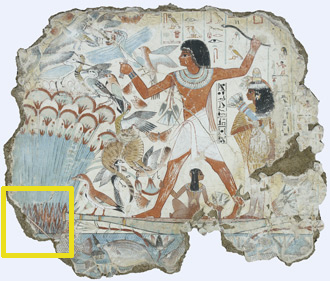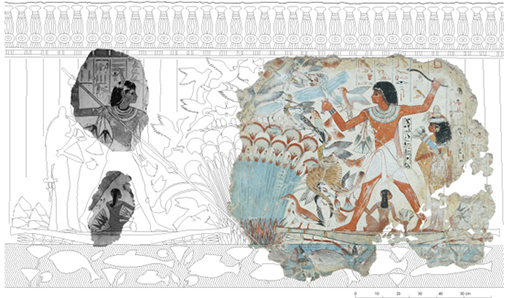4.2 Reconstruction
Despite first appearances, then, what we have here is not at all a ‘realistic’ image. It becomes still less realistic once we move from the surviving fragment of the original painting as it was cut out by D’Athanasi, and attend to the full scene as reconstructed by Egyptologists.
A diagonal line at the bottom left gives the clue (Figure 21).

Look at the reconstruction of the entire wall, based on the evidence of that diagonal line, and the evidence of other decorated tombs, as well as two other surviving but at present lost fragments from the Nebamun tomb itself (Figure 22).

The artificiality of the image is heightened once its symmetry is restored. There are now two Nebamuns, two Hatshepsuts, two boats, and two children, a male child on the left to balance the female child on the right.
The fishing and fowling scene is in short not a realistic snapshot of daily life at all, but a key motif from a repertoire that, Egyptologists have shown, extends back for well over a thousand years before the time of Nebamun, and was also, by the New Kingdom, a staple of Theban tomb-chapels.
A form of reed craft similar to our model is invariably depicted in fowling, fishing and harpooning scenes, found among the mural paintings of private tomb-chapels of the Old and Middle Kingdoms and of the New Empire, where it is called the wsekhet-boat. Such scenes, I believe, are as mythical as the pastimes of Horus.
Howard Carter, The Tomb of Tutankhamun, London, 1923–33, p. 244. (Carter is describing a model boat found in the tomb.)
Despite the powerful elements of naturalism, the ‘meaning’ of the composition is largely symbolic. It is an idealised evocation of harmony and prosperity, of a virtuous life. It is quite likely too that the accurately detailed wildlife in the marshes, the captured birds and the speared fish, represents forces of nature, potential chaos, being overcome by order. The cat, some of the accoutrements of Hatshepsut, and even the marshland landscape itself are associated with Hathor, goddess of fertility.
So the picture is ‘about’ both a life well-lived, and the forces of life and order overcoming chaos and death. The meaning of the scheme is produced by a combination of realism, that is, a naturalistic description of the way things are, and extreme conventionalism, wherein concrete images symbolise abstract ideas. The modern viewer can effortlessly recover and enjoy the realism, but the symbolism requires an intellectual effort we are seldom wont to extend, in modern culture, to the appreciation of ‘art’.
